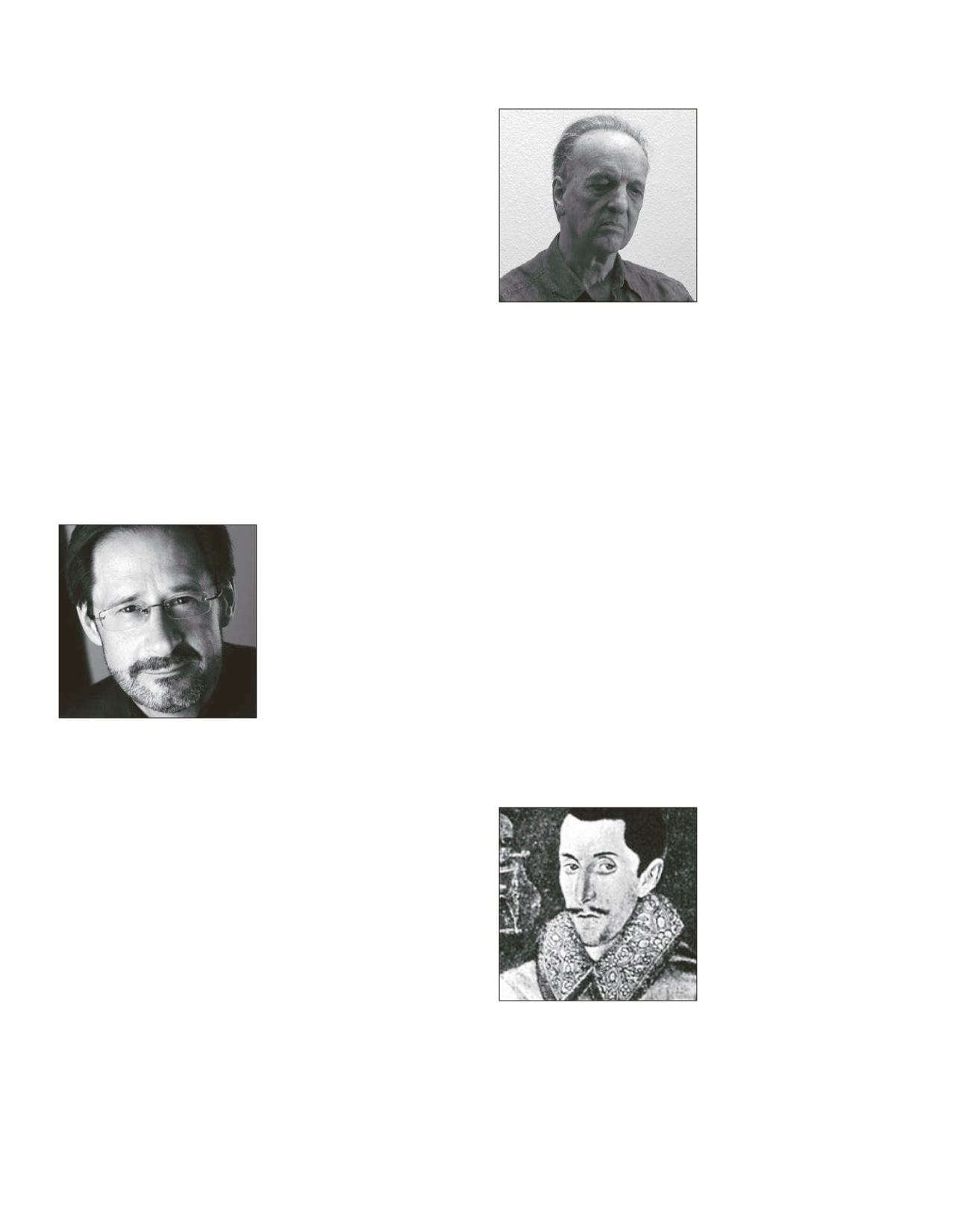

music for use in Catholic services (held secretly in private residences),
more o en than not in Latin. Byrd may have been playing with re, as it
were, but he was as clever a musical politician as he was a creative musical
force. By frequently dedicating his compositions to Queen Elizabeth, he se-
cured her patronage, thus managing his personal rebellion without loss of
life or livelihood. It is widely accepted that Byrd intended his Latin motets,
as well as his Mass settings for use in these secret religious services.
e four-voice motet
Ave verum corpus
was published in
, in his rst
collection of
Gradualia
. Rich with imitation, lush suspensions, and startling
chordal progressions, Byrd provides a moving setting for this plaintive text.
Ave verum corpus
natum de Maria Virgine,
vere passum,
immolatum in cruce pro homine:
cuius latus perforatum
unda uxit sanguine.
Esto nobis praegustatum,
in mortis examine.
O Dulcis, O Pie,
O Jesu li Mariae;
miserere mei. Amen.
Hail true body,
born of the Virgin Mary,
truly su ering,
sacri ced on the cross for all men:
From whose pierced side
owed blood.
Be a foretaste for us
in the trial of death.
O Sweet, O Merciful,
O Jesus, Son of Mary.
Have mercy on us. Amen.
STE9EN STUC.< (1949–2016)
Whispers
Pulitzer Prize–winning composer
Steven Stucky was widely recog-
nized as one of the leading Amer-
ican composers of his generation.
He wrote commissioned works for
many of the major American or-
chestras and such prestigious orga-
nizations as the Chicago Symphony
Orchestra, Philadelphia Orchestra,
and the Carnegie Hall Corporation,
as well as Chanticleer. He was long
associated with the Los Angeles
Philharmonic, where he was resi-
dent composer from
to
.
Commissioned for Chanticleer’s th anniversary in
,
Whispers
was
conceived as a companion piece to his
Drop, Drop Slow Tears
, which was
premiered in
. e earlier work is constructed around a reminiscence of
the music of Orlando Gibbons. Similarly,
Whispers
recalls fragments of Wil-
liam Byrd’s
Ave verum corpus
, surrounding those fragments with his own
setting of lines fromWalt Whitman’s “Whispers of Heavenly Death” (
).
Stucky wrote, “In both the Whitman and Byrd, thoughts and images of
death are so transmuted by the power of great art that the result is not sad-
ness, but instead a kind of mystical exaltation.
is is a blessing that we
need more than ever in our own time, and one that the superb singing of
Chanticleer has delivered to listeners (and composers) for years. Inspired
as much by Chanticleer’s own artistry and style as by Byrd or Whitman, this
piece is o ered in celebration of those wonderful years.”
Whispers of heavenly death, murmer’d I hear,
Labial gossip of night, sibilant chorals,
Footsteps gently ascending, mystical breezes wa ed so and low,
Ripples of unseen rivers, tides of a current owing, forever, owing,
I see, just see skyward, great cloud-masses.
Mournfully slowly they roll, silently swelling and mixing,
With at times a half-dimm’d sadden’d far-o star,
Appearing and disappearing.
ALLEN SHEARER (b. 1943)
Nude Descending a Staircase
A composer, singer and teacher
living in San Francisco’s East Bay,
Allen Shearer teaches voice at UC–
Berkeley. Trained in Europe and the
US, he earned diplomas in concert
singing and opera at the Akademie
Mozarteum in Salzburg as well as a
PhD in music at UC–Berkeley. He
studied composition in Paris on the
Charles Ives Scholarship, and spent
a year in Italy on the Rome Prize
Fellowship. As a composer, Shearer
has received many honors, includ-
ing the Silvia Goldstein Award, as
well as funding from
e National
Endowment for the arts for several of his works. e witty text of
Nude De-
scending a Staircase
, which recalls Duchamp’s famous painting of the same
name, is by X.J. Kennedy, and was written in
. Complex rhythms, hu-
morous asides, and surprising textual painting make this an engaging work.
“Because I am a singer myself, writing vocal music is a particular pleasure
for me. Setting this whimsical poem provides a diversion,” says Shearer.
Toe upon toe, a snowing esh,
a gold of lemon, root and rind,
she si s in sunlight down the stairs
with nothing on. Nor on her mind.
We spy beneath the banister
a constant thresh of thigh on thigh;
her lips imprint the swinging air
that parts to let her parts go by.
One-woman waterfall, she wears
her slow descent like a long cape
and pausing on the nal stair,
collects her motions into shape.
THOMAS MORLEY (ca. 1557–1602)
Now is the Month of Maying
(arranged by Evan Price)
omas Morley had the rare priv-
ilege of seeing most of his works
published while he lived. Why? In
the England of Elizabeth I, the li-
cense to print and publish works
was granted to few. One of the hold-
ers of that license was William Byrd.
When Byrd’s monopoly on publish-
ing expired in
, his industrious
and clever pupil, Morley, applied
for the license; a er two years of
waiting, Morley nally received it.
While Byrd published primarily
sacred works, Morley focused his
e orts on a surge of secular music.
His madrigals could be sung in a casual setting as easily as in a more formal
one. A paradigm of the English madrigal
Now is the Month of Maying
is
perhaps one of Morley’s most famous compositions, even though it (like a
number of Morley’s other works) is based on an Italian canzonet by Orazio
Vecchi. Passages of joyful homophony are interspersed with trademark “fa-
la-la” polyphony, creating an ebullient and e ervescent song that happily
welcomes the return of spring and its “lustier” activities.
6WHYHQ 6WXFN\
Allen Shearer
Thomas Morley
RAVINIA MAGAZINE | JULY 30 – AUGUST 5, 2018
102









